Use of captured German 105 and 128 mm anti-aircraft guns
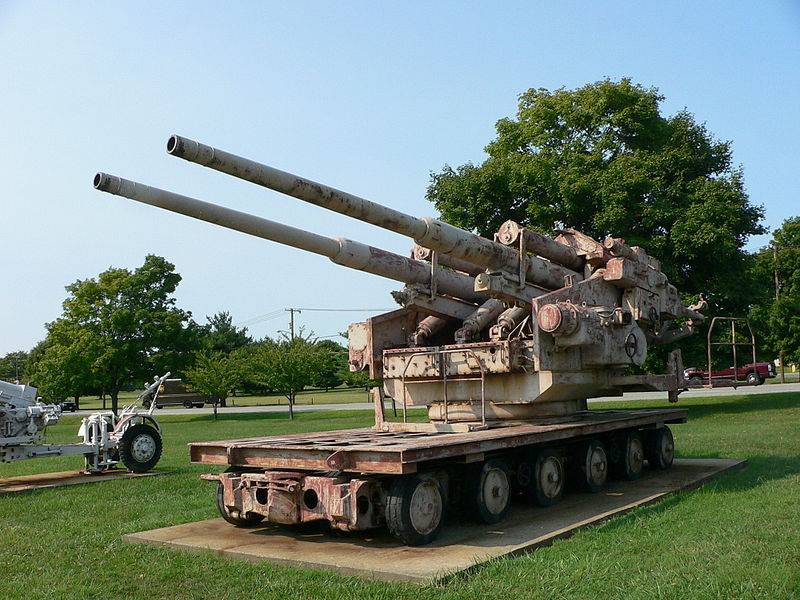
In addition to the well-known 88-mm anti-aircraft guns, the air defense units of Nazi Germany had 105 and 128-mm anti-aircraft guns. The creation of such long-range and high-altitude artillery systems was associated with an increase in the speed and altitude of the bombers, as well as with the desire to increase the area of destruction of fragmentation anti-aircraft projectiles.
During World War II, most of the German heavy anti-aircraft guns were 88-mm guns, the effectiveness of which no longer fully corresponded to modern requirements. At the beginning of 1944, the command of the 1st Air Defense Division of Berlin reported to the leadership:
Under these conditions, 105-128-mm anti-aircraft guns, coupled with radars, played a very important role in the air defense system of the Third Reich. These long-range anti-aircraft guns, even at night, could conduct very accurate fire, opening it before enemy bombers were in the zone of destruction of more massive 88-mm guns.
The value of 105-128-mm anti-aircraft guns rose sharply in the second half of the war, when the British and Americans launched an "air offensive" on German cities, strategically important industrial facilities and transport hubs. British and especially American heavy bombers often carried out bombing from an altitude of 7-9 km. In this connection, the most effective in the fight against them were large-caliber anti-aircraft guns with high ballistic characteristics.
Although the German air defense systems were not able to fully protect the covered objects from air strikes, it should be recognized that the German anti-aircraft guns acted quite effectively. And the allies achieved their goals only due to multiple numerical superiority and often at the cost of high losses.
For example, in the course of 16 massive raids on Berlin, the British lost 492 bombers, which amounted to 5,5% of all aircraft participating in the raids. According to statistics, for one downed bomber there were two or three damaged, many of which were later written off due to the impossibility of recovery.
American heavy bombers carried out raids in the daytime and, accordingly, suffered more significant losses than the British. Particularly indicative was the raid of the "flying fortresses" B-17 in 1943 on the ball bearing plant, when the German air defense forces destroyed about half of the bombers participating in the raid.
The role of anti-aircraft artillery is also great in the fact that a very large percentage (more than the allies admit) of bombers dropped bombs anywhere, just to get out of the shelling or not to enter the anti-aircraft fire zone at all.
105-mm anti-aircraft guns 10,5 cm Flak 38 and 10,5 cm Flak 39
In 1933, the Reichswehr command announced a competition for the creation of a 105-mm universal anti-aircraft gun, which was also supposed to be used in navy... In 1935, Friedrich Krupp AG and Rheinmetall-Borsig AG presented two prototypes of their 105-mm anti-aircraft guns, which passed comparative tests in the same year. According to the test results, the 105-mm gun from Rheinmetall was recognized as the best. In the second half of 1937, a modified version of this gun was put into service under the name 10,5 cm Flak 38 (German 10,5 Flugabwehrkanone 38). By September 1, 1939, 64 guns had been produced.
Externally, the Flak 38 resembled the upscaled Flak 36. But there were many design differences between the two. The 105-mm anti-aircraft guns were guided by electro-hydraulic drives. The four-gun Flak 38 battery was equipped with a 24 kW DC generator, which was rotated by a gasoline engine. The generator supplied power to the electric motors mounted on the cannons. Each gun had four electric motors: vertical guidance, horizontal guidance, rammer and automatic fuse installer.
In the combat position, the gun weighed 10 240 kg, in the traveling position - 14 600 kg. For transportation, like the 88 mm Flak 18/36/37, a Sonderanhanger 201 conveyor with two single-axle rolling bogies was used.
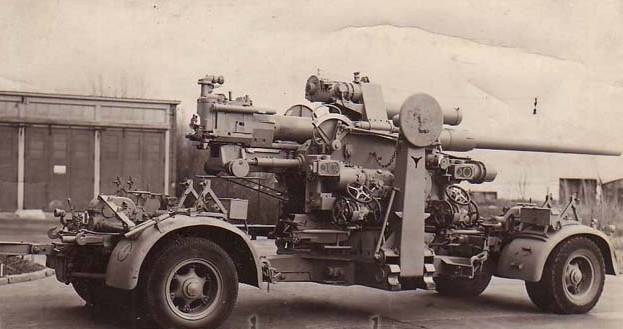
10,5 cm Flak 38 in transport position
From the ground, the gun fired from a cruciform gun carriage, which made it possible to conduct a circular fire with elevation angles from −3 ° to + 85 °. A crew of 11 people transferred the gun from the marching position to the firing position in 15 minutes.
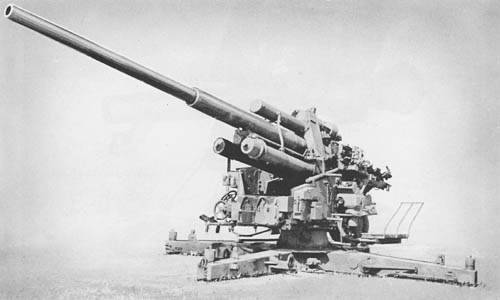
10,5 cm Flak 38 in firing position
In addition to the towed version, 105-mm anti-aircraft guns were installed on railway platforms and in stationary positions. Several dozen 105-mm anti-aircraft guns were deployed in the fortifications of the Atlantic Wall. Where are they, in addition to countering the enemy aviation, were supposed to fire on ships and carry out anti-amphibious defense.
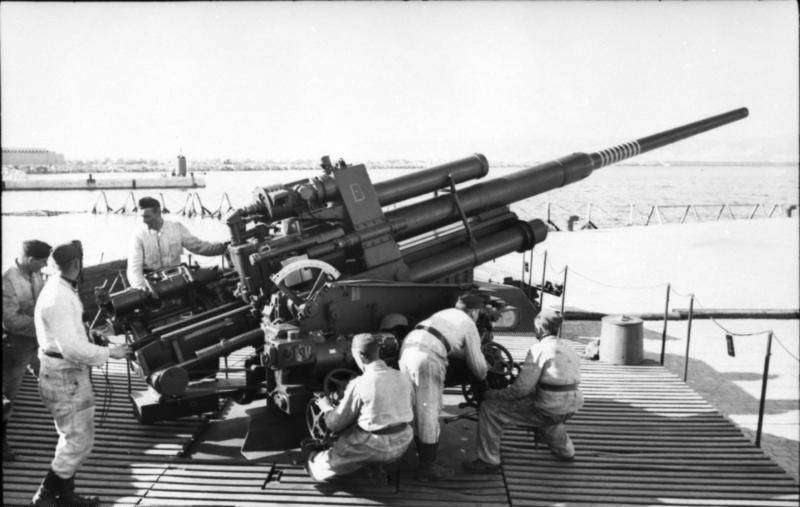
105-mm anti-aircraft gun in a firing position
The 10,5 cm Flak 38 gun had good ballistic characteristics. A fragmentation projectile weighing 15,1 kg left a barrel with a length of 6 648 mm (63 clb) at a speed of 880 m / s. At the same time, the reach in height was 12 m. When a projectile containing 800 kg of TNT burst, about 1,53 lethal fragments were formed, the confident zone of destruction of air targets reached 700 m. An armor-piercing projectile weighing 15 kg had an initial velocity of 15,6 m / s and at a distance of 860 m, it penetrated 1500 mm armor along the normal. Rate of fire: 135-12 rounds / min.
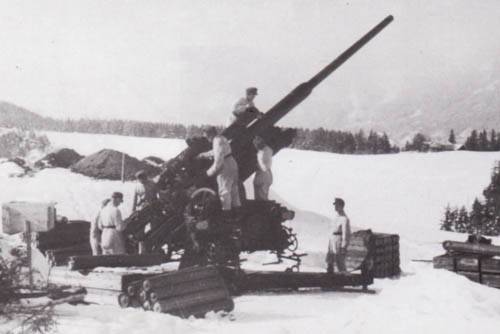
In 1940, the troops began to receive 105-mm Flak 39 anti-aircraft guns.
This gun differed from the Flak 38 in the design of the barrel, carriage and the type of electric motors of the guidance system. The Flak 39 barrel was made integral, which made it possible to change not the entire barrel, but only its individual most worn parts. The Flak 39 barrel had a free tube, which consisted of three parts: a chamber, a middle and a muzzle. The chamber and middle parts were connected at the front end of the chamber, and the joint between them was overlapped by a sleeve. The middle and muzzle parts of the pipe were connected in the threaded part of the channel, and the joint between them did not overlap. The parts of the free pipe were assembled in a shell or collecting pipe and tightened with nuts. The advantage of the composite barrel was the possibility of replacing only one middle part, which is most susceptible to "swing".
The 10,5 cm Flak 39 anti-aircraft gun was equipped with an electric drive with industrial frequency AC motors, which made it possible to do without a special electric generator and connect to city power grids.
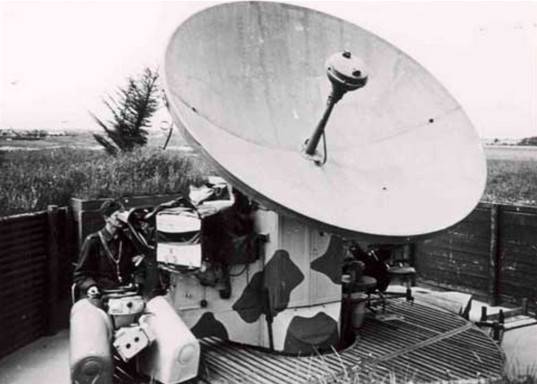
Anti-aircraft fire control radar Würzburg
To guide the firing of the Flak 39 anti-aircraft battery, the guidance system was used, worked out at 8,8 cm Flak 37. Its essence was that instead of the aiming scale, two double dials with multi-colored arrows appeared on the gun. After the target was taken to be accompanied by the Würzburg anti-aircraft fire control radar or the calculation of the Kommandogerät 40 optical rangefinder with an analog mechanical computer, using radar or optical anti-aircraft fire control devices, the following were determined: range to the target, flight altitude and angular coordinates - azimuth and elevation. On their basis, data for firing was generated, which were transmitted via cable to the guns.
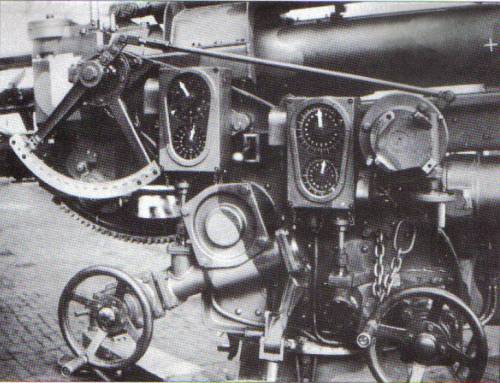
At the same time, one of the colored arrows on the dials indicated a certain elevation angle and direction to the target. The gun crew combined the second arrows with the indicated values, using a special automated mechanical device entered data into the remote fuse of the anti-aircraft projectile and sent it to the bolt. The gun was automatically guided to a given point by an electric drive. And there was a shot.
In total, about 1945 FlaK 4/200 anti-aircraft guns were produced by February 38. Due to the significant mass and complex device, 39-mm anti-aircraft guns did not receive widespread use in anti-aircraft battalions tank and infantry divisions. And they were mainly used in the anti-aircraft units of the Luftwaffe.
In August 1944, the anti-aircraft units of the Luftwaffe were armed with 2 FlaK 018/38 anti-aircraft guns. Of this number, 39 are in a towed version, 1 are mounted on railway platforms, and 025 are in stationary positions.
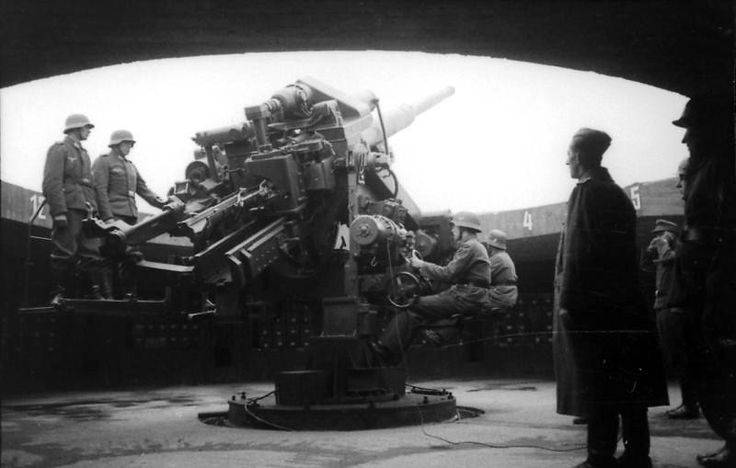
Calculation of 10,5 cm Flak 39 in the air defense turret
Taking into account the fact that a 105-mm projectile, when bursting, formed a fragmentation field of a larger area than that released from an 88-mm FlaK 41, the average consumption of projectiles per shot down aircraft for FlaK 39 was 6 units, and for FlaK 000 - 41 units. At the same time, the firing range and reach of these guns were very close.
The FlaK 38/39 artillery unit was used as part of a twin 105 mm marine universal mount 10,5 cm SK C / 33. Moreover, in the installations of the early release, barrels similar to the FlaK 38 were used, and in the later ones - the FlaK 39.
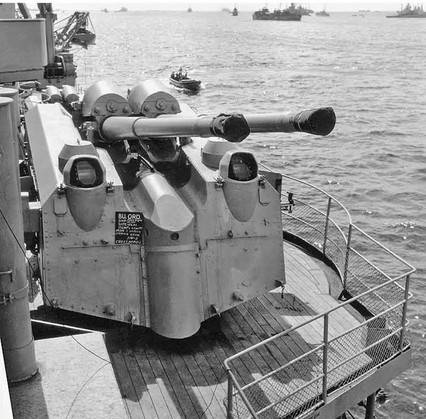
Twin 105-mm universal artillery mount 10,5 cm SK C / 33
The installation weighed about 27 tons and could make 15-18 rounds / min. To compensate for the rocking of the ship, there was an electromechanical stabilizer.
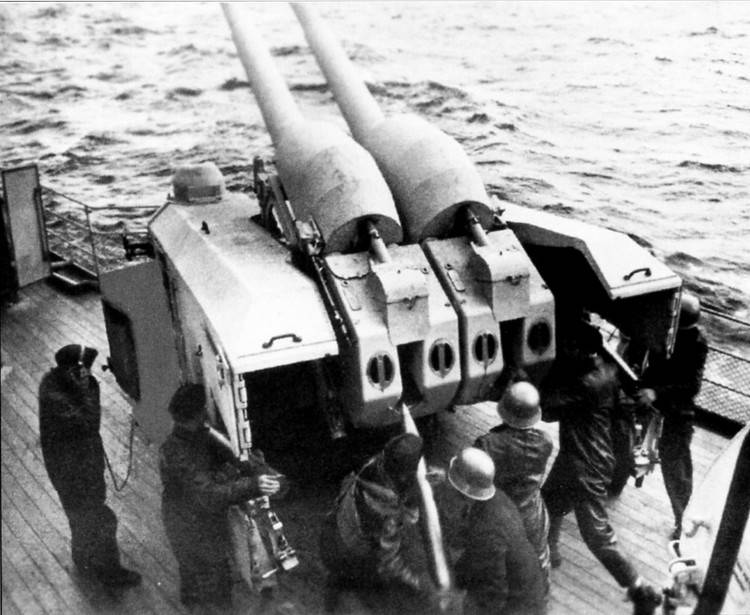
The 105-mm SK C / 33 twin was installed on heavy cruisers such as Deutschland and Admiral Hipper, battle cruisers of the Scharnhorst class, and battleships of the Bismarck class. They were also supposed to be installed on the only German aircraft carrier "Graf Zeppelin". A number of 105mm twin guns were deployed in the vicinity of naval bases, and they also participated in repelling enemy raids.
128-mm anti-aircraft guns 12,8 cm Flak 40 and 12,8 cm Flakzwilling 42
The 12,8 cm Flak 40 was the heaviest anti-aircraft gun used by the Germans in World War II. Rheinmetall-Borsig AG received the terms of reference for the development of this system in 1936. But at the first stage, this topic was not among the priorities, and the intensity of work on the creation of a 128-mm anti-aircraft gun sharply accelerated after the first raids of British bombers.
Initially, it was assumed that 128-mm guns (by analogy with 88 and 105-mm anti-aircraft guns), in addition to the anti-aircraft units of the Luftwaffe, would be used in the anti-aircraft units of the Wehrmacht, and the 128-mm anti-aircraft gun was designed in a mobile version. To transport the gun, they tried to use two single-axle trolleys.
However, with the weight of the installation in the combat position of more than 12 tons, its transportation was only possible over very short distances. The load on the bogies was excessive and the gun could only be towed on paved roads. In this regard, the engineers suggested removing the barrel and transporting it on a separate trailer. But during the tests of the prototype, it turned out that such a disassembly turned out to be inappropriate - the installation still remained too heavy. As a result, a special four-axle conveyor was developed to transport the unassembled weapon.
At the end of 1941, during the trial operation of the first batch of six 128-mm anti-aircraft guns, it turned out that with a mass in the transport position of more than 17 tons, this gun is completely unsuitable for use in the field. As a result, the order for towed anti-aircraft guns was canceled, and priority was given to guns deployed permanently.
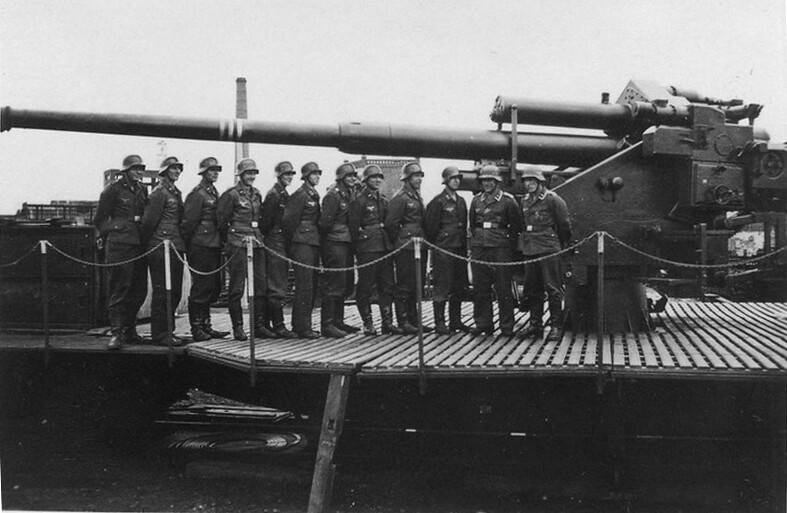
128-mm anti-aircraft gun Flak 40 with the calculation
Anti-aircraft 128-mm cannons were installed on the concrete platforms of the air defense towers and special metal platforms. To increase the mobility of anti-aircraft batteries, Flak 40 guns were mounted on railway platforms.
The 128 mm Flak 40 anti-aircraft gun had impressive capabilities. With a barrel length of 7 mm, a fragmentation projectile weighing 835 kg accelerated to 26 m / s and could reach an altitude of more than 880 m. But due to the design features of anti-aircraft shells fuses, the ceiling did not exceed 14 m. up to + 000 °. Rate of fire - up to 12 rounds / min.
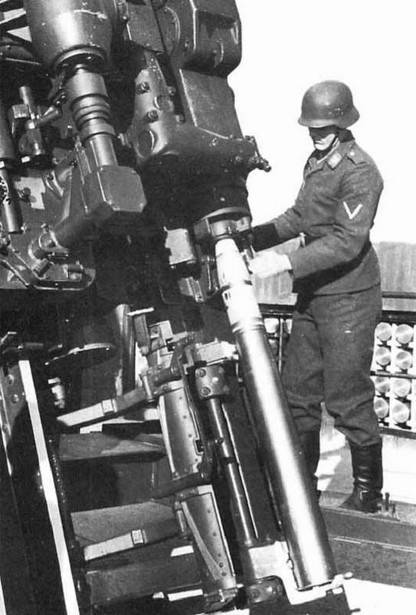
The mechanisms for aiming, supplying and sending ammunition, as well as installing the fuse, were driven by 115 V AC electric motors. Each anti-aircraft battery, consisting of four guns, was attached to a 60 kW gasoline power generator.
The fragmentation projectile contained 3,3 kg of TNT, when it was detonated, a fragmentation field with a radius of destruction of about 20 m was formed.In addition to the usual fragmentation projectiles for 128-mm anti-aircraft guns, a small batch of active-rocket projectiles with an increased firing range was fired. Attempts were also made to create radio fuses, which ensured a non-contact detonation of a projectile when the distance between it and the target was minimal, as a result of which the probability of damage increased sharply.
However, even with conventional fragmentation shells, the effectiveness of the Flak 40 anti-aircraft guns was higher than that of other German anti-aircraft guns. So, for one downed enemy bomber, an average of 3 000-mm shells were spent. The 128-mm Flak 88 anti-aircraft guns used an average of 36 rounds to obtain the same result.
The fairly high performance of 128-mm anti-aircraft guns was largely due to the fact that the most advanced German radar and optical systems were used to control them.
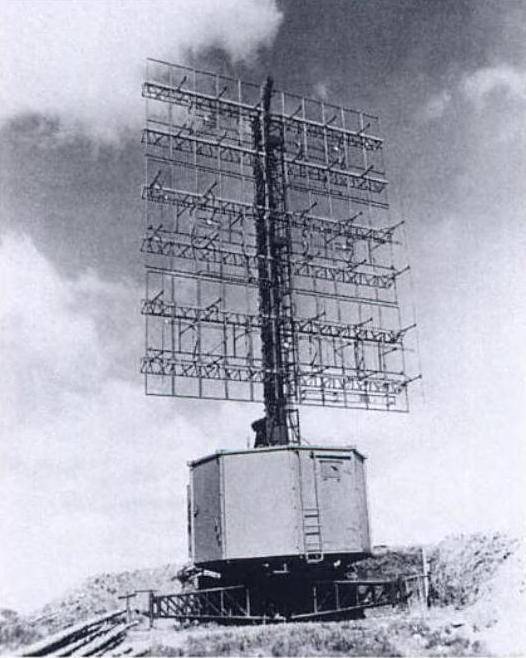
Radar FuMG 450 Freya
Preliminary detection of air targets was assigned to the Freya family of radars. Most often these were stations of the FuMG 450 type operating at a frequency of 125 MHz. Typically, such radars with a range of more than 100 km were located at a distance of 40-50 km from anti-aircraft batteries.
The data issued by the radar on the azimuth to the target and the target elevation angle were processed by the computing center. After that, the course and flight speed of enemy bombers were determined. The standard PUAZO of the Flak 40 battery in the daytime was the Kommandogerät 40 optical calculating device.
At night, aiming fire was directed by radars of the Würzburg family. These radars with a parabolic antenna, after acquiring a target for tracking, provided a fairly accurate measurement of the range, altitude and speed of the target.
The most advanced of the serially produced radar was the FuMG 65E Würzburg-Riese. It had an antenna with a diameter of 7,4 m and a transmitter with a pulse power of 160 kW, providing a range of more than 60 km.
Serial production of 128-mm anti-aircraft guns began in 1942. Considering the fact that the Flak 40 was quite complex and expensive to manufacture, these guns were produced less than the 105 mm Flak 38/39.
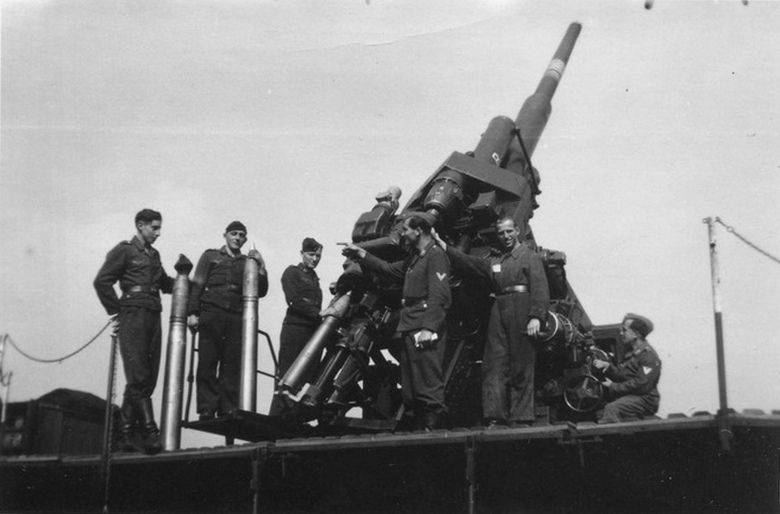
128-mm anti-aircraft guns were used to protect the most important administrative and industrial centers. In August 1944, the anti-aircraft artillery units of the Luftwaffe numbered only 449 Flak 40s, of which 242 were stationary installations, 201 were part of railway batteries and 6 were towed guns. The maximum number of 128-mm anti-aircraft guns was reached in January 1945, when there were 570 units in service.
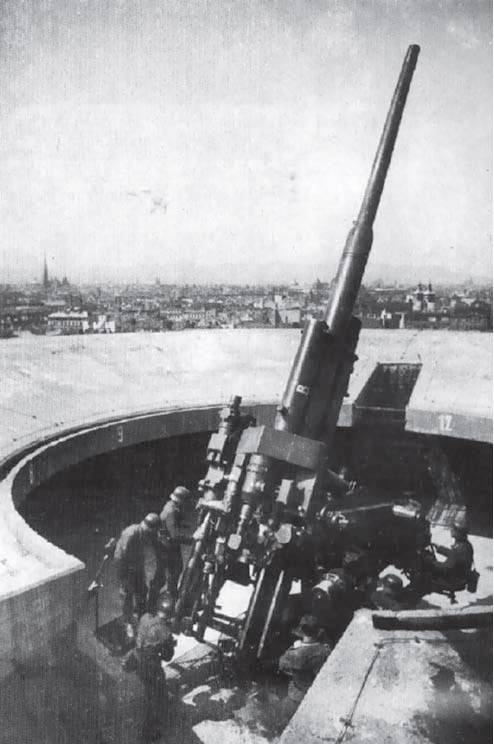
The adoption of powerful 128-mm anti-aircraft guns significantly increased the potential of the German air defense system. At the same time, the German command, expecting an increase in the intensity of the Allied aviation raids, demanded the creation of even more long-range and powerful anti-aircraft guns.
From the second half of 1942, the development of a 128-mm anti-aircraft gun with an increased volume of the charging chamber and an elongated barrel was carried out. This gun, known as the Gerat 45, was supposed to provide a 15-20% increase in range and ceiling compared to the Flak 40. However, a sharp increase in the muzzle velocity led to accelerated wear of the barrel, and the increased recoil required an increase in the design of the gun. The finishing of the Gerat 45 was delayed, and before the end of hostilities, it was not possible to launch the new 128-mm anti-aircraft gun into mass production. The same fate befell 150mm (Gerat 50) and 240mm anti-aircraft guns (Gerat 80/85), developed by Friedrich Krupp AG and Rheinmetall-Borsig AG.
The idea of creating a coaxial 40-mm anti-aircraft gun based on the Flak 128 turned out to be more viable. A double-barreled anti-aircraft gun with the same range and reach in height made it possible to increase the density of fire.
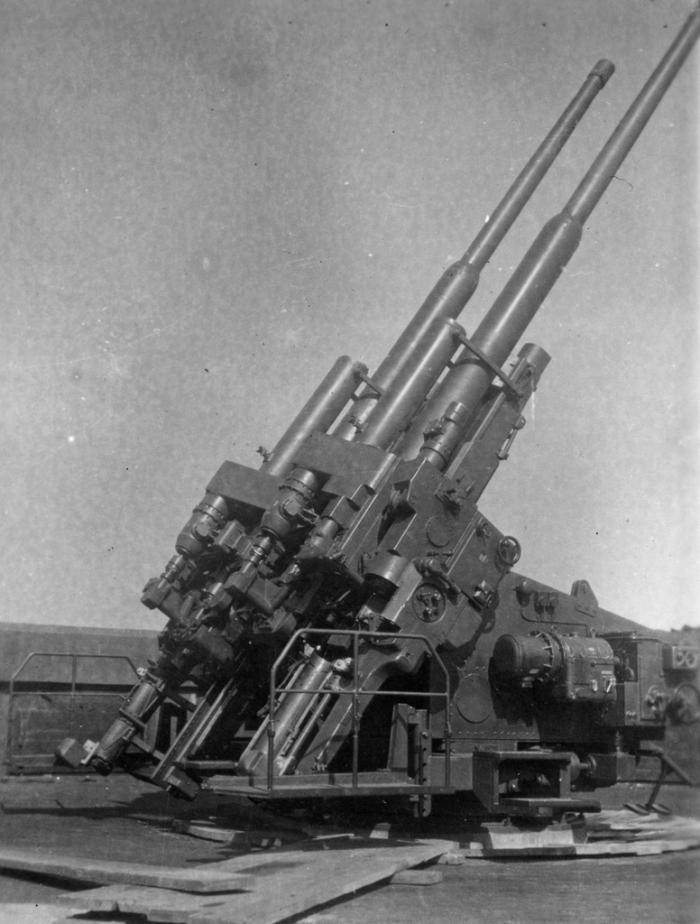
12,8 cm Flakzwilling 40
In the middle of 1942, at the production facilities of Hannoversche Maschinenbau AG in Hanover, the assembly of 128-mm Gerat 44 twin anti-aircraft artillery mounts began, which received the designation 12,8 cm Flakzwilling 40 after being adopted.
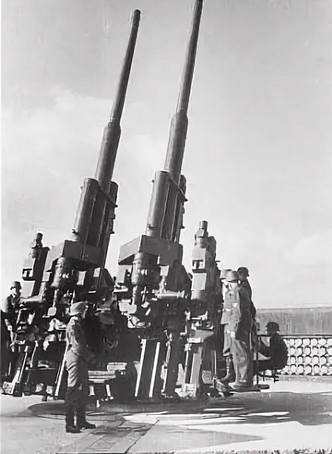
Two 128-mm barrels were located in a horizontal plane and had loading mechanisms deployed in opposite directions. The mass of the installation in the firing position exceeded 27 tons. A carriage from an experienced 150-mm anti-aircraft gun Gerat 50 was used for it. The installation was transported partially disassembled (with the barrels removed) on two biaxial bogies. Thanks to the use of an automated charger, the total rate of fire reached 28 rds / min. The anti-aircraft gun was served by a crew of 22 people.
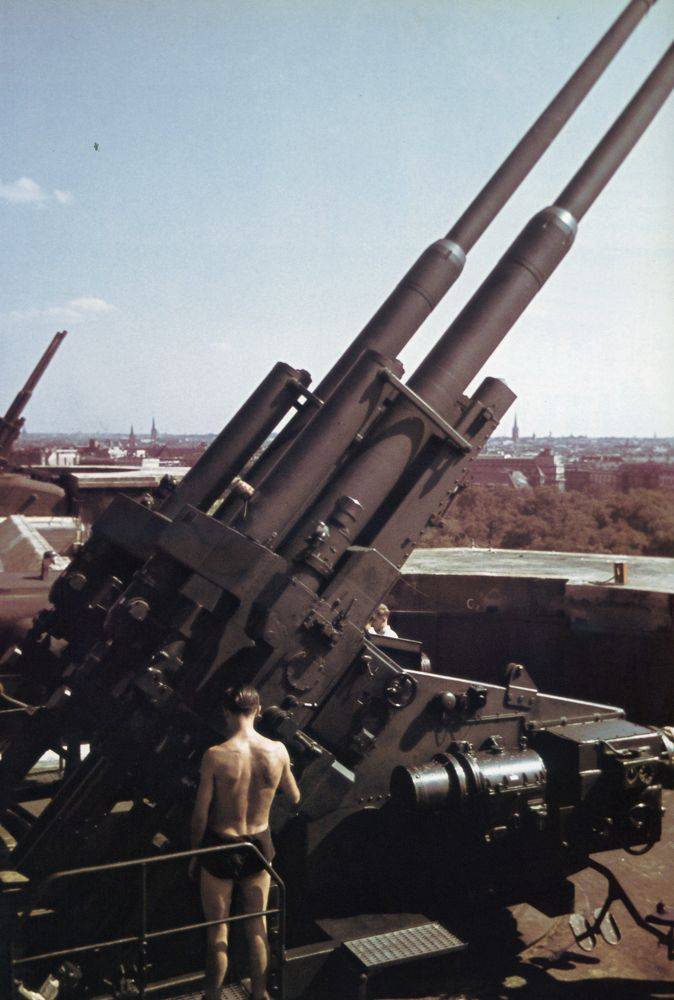
Provided only for the stationary installation of such weapons on a turntable, providing a circular fire. To protect the most important cities in Germany, most of the 12,8 cm Flakzwilling 40 was placed on the upper platforms of the anti-aircraft towers. The anti-aircraft battery consisted of four paired installations, which made it possible to create an impressive fire barrier on the way of enemy aircraft.
The production rate of the 12,8 cm Flakzwilling 40 was slow. By January 1, 1943, 10 units were produced. For the entire 1943, 8 units were built. In total, 1945 twin anti-aircraft guns were delivered by February 34.
For the armament of large warships on the basis of the 12,8 cm Flakzwilling 40, the KM40 tower was created. Although they did not manage to install such 128-mm systems on any German ship before the surrender of Germany, several KM40 towers defended the large ports of Germany.
The use of 105 and 128-mm German anti-aircraft guns in the USSR
Soviet specialists first got acquainted with the 105 mm Flak 38 guns in 1940. Four guns purchased from Germany were delivered to an anti-aircraft artillery range near Evpatoria and underwent comprehensive tests.
German Flak 38s were tested in conjunction with the Soviet 100-mm anti-aircraft guns L-6 and 73-K. The ballistic data of the German and Soviet cannons were almost the same, but the accuracy of the "German" was significantly higher. In addition, when a German 105-mm projectile burst, more than twice as many lethal fragments were formed. In terms of barrel survivability and reliability, the Flak 38 surpassed our 100mm anti-aircraft guns. Despite the best performance of the German gun, the 100-mm 73-K anti-aircraft gun was recommended for mass production. Which, however, before the beginning of the Great Patriotic War, they did not manage to bring it to an acceptable state.
After the Red Army entered the territory of Germany, the enemy tried to use a number of 105-mm anti-aircraft guns for firing at ground targets. The range of the Flak 38/39 guns made it possible to use them to fire at targets deep in the Soviet defenses, and the armor-piercing 105-mm shells were capable of destroying any Soviet tank. However, due to the high cost and very low mobility for a field gun, the Germans fired from 105-mm anti-aircraft guns at ground targets only as a last resort.
As for the 12,8 cm Flak 40 and 12,8 cm Flakzwilling 40, due to the stationary placement, only a few cases were reliably recorded when they fired at the advancing Soviet troops.
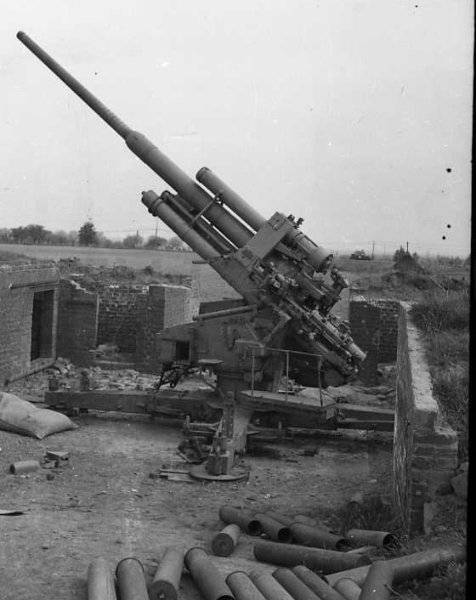
Due to the fact that most of the 105 and 128-mm anti-aircraft guns were in their positions until the last moment, our troops captured several hundred serviceable Flak 38/39 and Flak 40, as well as a large amount of ammunition for them.
In the first post-war decade, 105 and 128-mm anti-aircraft guns of German production, which underwent refurbishment, were in service with the USSR Air Defense Forces. Instead of German anti-aircraft fire control devices, Soviet PUAZO-4 were used together with captured heavy anti-aircraft guns.
According to American data, 105-mm anti-aircraft guns, served by Soviet crews, were used against American aircraft in Korea. In the mid-1950s, captured 105 and 128-mm anti-aircraft guns were supplanted in the Soviet Army by the 100-mm KS-19 and 130-mm KS-30.
Use of 105 and 128 mm German anti-aircraft guns in other countries
The only state where 1960-mm German Flak 105 anti-aircraft guns were operated until the early 39s was Czechoslovakia.
During wartime, the enterprises of the protectorate of Bohemia and Moravia actively worked in the interests of the armed forces of Nazi Germany. The hands of the Czechs collected 25% of all German tanks and self-propelled guns, 20% of trucks and 40% of rifle weapons German army. According to archival data, at the beginning of 1944, the Czech industry on average monthly supplied the Third Reich with about 100 self-propelled artillery guns, 140 infantry guns, 180 anti-aircraft guns. It is quite natural that the German command sought to protect the Czech factories from air strikes, and deployed large air defense forces around them. Including anti-aircraft batteries 88 and 105-mm anti-aircraft guns, coupled with radars FuMG-65 Würzburg D, which received primary information from surveillance radars of the Freya family: FuMG-44 and FuMG-480.

Antenna post of the FuMG-65 radar in the exposition of the Leshany Museum near Prague
In May 1945, on the territory of Czechoslovakia there were up to one and a half hundred heavy anti-aircraft guns: 88-mm Flak 36/37 and Flak 41, as well as 105-mm Flak 39. Subsequently, most of this German inheritance was used for its intended purpose or was sold abroad. The Czechs also got 10 Würzburg and Freya radars, which served until 1955. After the establishment of the communist regime in the country and the beginning of large-scale deliveries of Soviet radar equipment, the German radar stations were decommissioned.
However, after the decommissioning of German radars, the service of the 88-mm Flak 41 and 105-mm Flak 39 continued until 1963. It was in this year that the 185th anti-aircraft missile brigade "Prykarpattya", equipped with the SA-75M "Dvina" air defense system, began combat duty.
During the preparation of this publication, it was not possible to find information about the supply of the Flak 38/39 and Flak 40 anti-aircraft batteries by the Nazis to other countries. However, a number of 105mm anti-aircraft guns deployed along the Atlantic coast were captured by the Allies in France, Norway and the Netherlands.
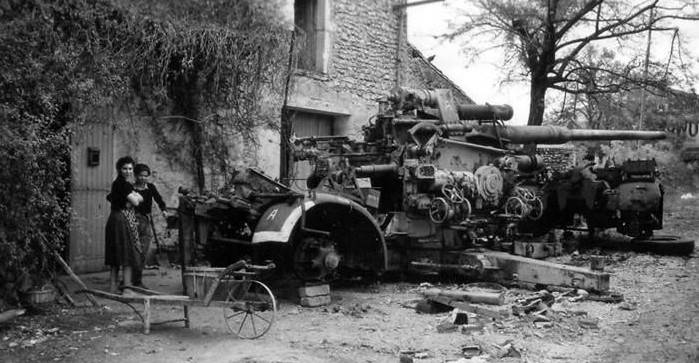
German 105mm anti-aircraft gun abandoned in France
In the post-war period, 105-mm German anti-aircraft guns were in service with the French, Norwegian and Yugoslav coastal defense units. Although these guns theoretically had the ability to fire at aircraft, the lack of anti-aircraft fire control devices devalued their anti-aircraft potential.
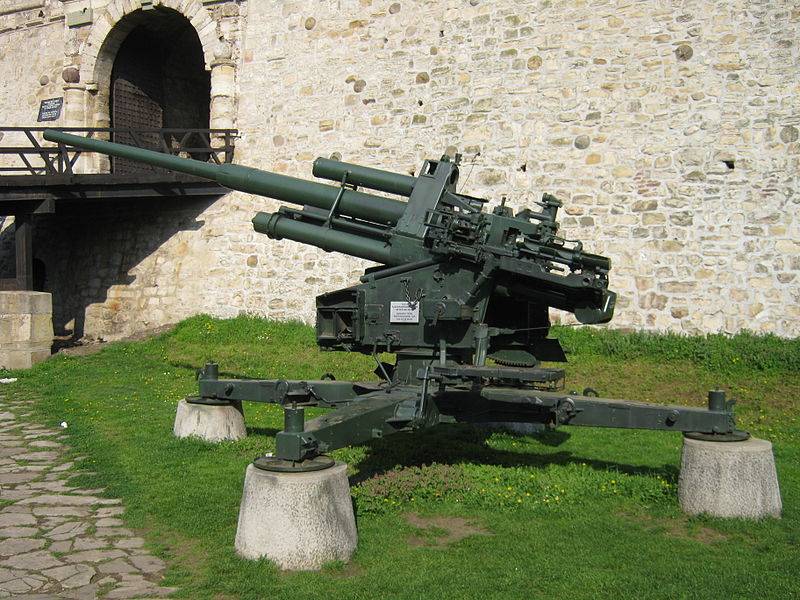
105-mm anti-aircraft gun FlaK 38 in the military museum of Belgrade
The 10,5 cm SK C / 33 naval general purpose guns were used by the French Navy to re-equip two Italian Capitani Romani-class light cruisers transferred as reparations.
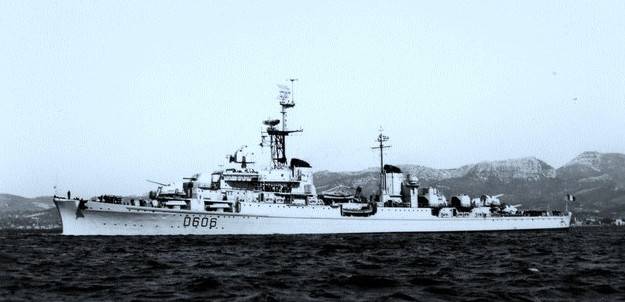
Destroyer "Chatoreno"
During the modernization of former Italian light cruisers, 135 mm turret artillery mounts 135 mm / 45 OTO / Ansaldo Mod. 1938 was replaced with captured 105 mm German guns. Three twin 105-mm units were installed instead of towers 1, 3 and 4. Instead of tower 2, a twin unit with 57-mm anti-aircraft guns appeared. The French reclassified the Italian cruisers as destroyers. The active service of the destroyers Chatoreno and Guichen continued until the early 1960s.
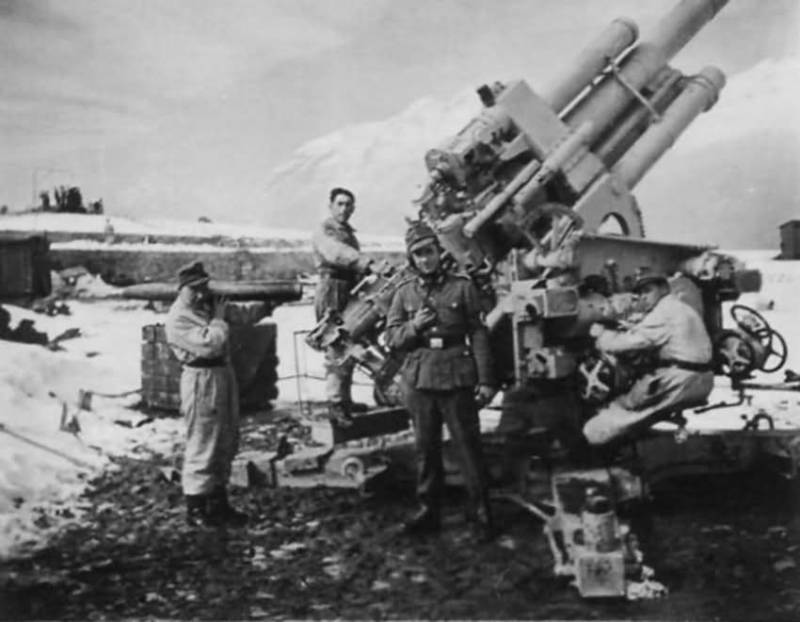

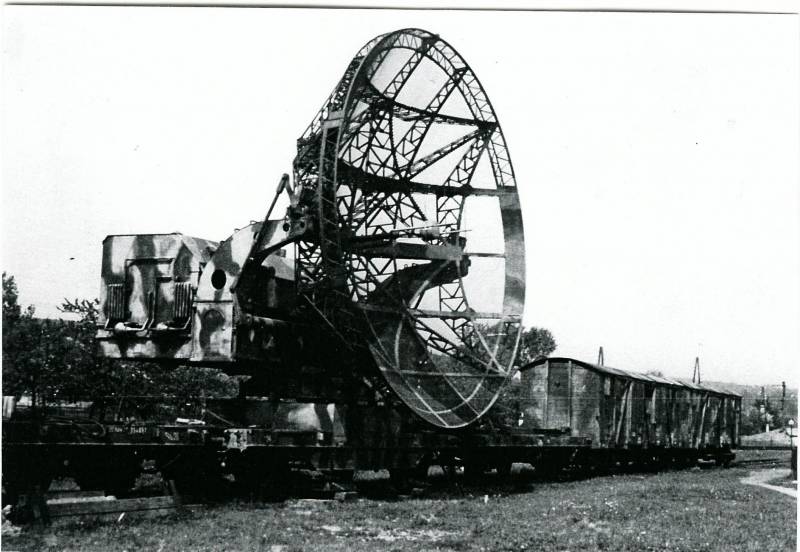
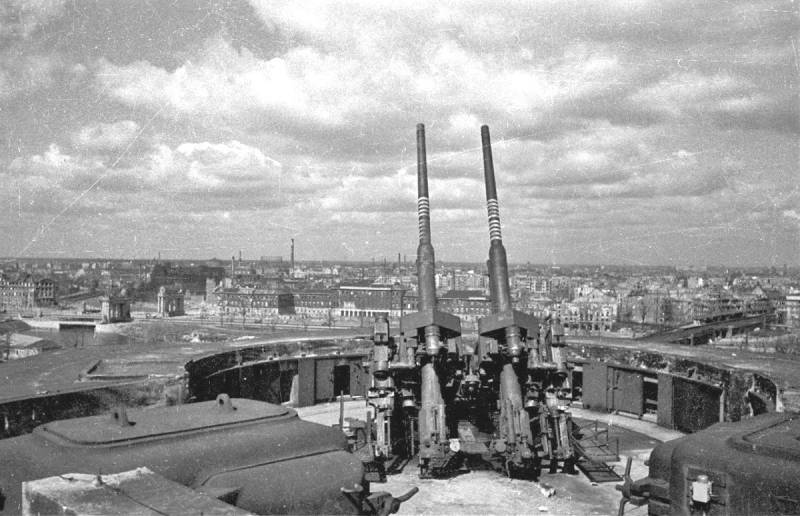
Information